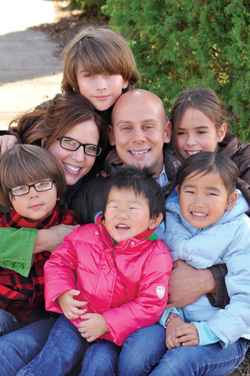 Three days after arriving home last winter with their newly adopted daughter, Ashleigh and Eric Sanzone broke the rules.
Three days after arriving home last winter with their newly adopted daughter, Ashleigh and Eric Sanzone broke the rules.
“We had also adopted another daughter from China and had been told both times not to take our child to a doctor right away,” Ashleigh remembers. “The agency said that instead of rushing out, we should take time to simply be together and bond.”
Instead, the Virginia Beach couple decided that a trip to their pediatrician couldn’t wait. Sarahjoy’s heart wasn’t beating right, Ashleigh says; she could hear it pounding when they hugged. And Sarahjoy, 26 months old at the time, didn’t want to walk or exert herself.
Before meeting their new daughter, Ashleigh and Eric had talked with a doctor hired by the adoption agency. She reviewed Sarahjoy’s medical file, Ashleigh recalls, and told them that the little girl had a heart defect, but it appeared to be minor. Someday, surgery might be required – but that was only a possibility, something that might have to be addressed in the future.
The Sanzones’ pediatrician came to a different conclusion: After examining Sarahjoy, she recommended that they see a pediatric cardiologist immediately.
Two days later, an echocardiogram and exam by Dr. Michael Vance at CHKD showed that Sarahjoy’s heart condition wasn’t minor at all – and surgery would be necessary. “I asked, ‘In the next few months?’ and was told, ‘No, next week if we can,’” Ashleigh recalls. “They said her heart was nearly twice the size it should have been.”
Sarahjoy had a large ventricular septal defect (VSD), a hole in the wall separating the heart’s two pumping chambers, which are called ventricles. Usually, the condition is detected around birth and surgically repaired, if necessary, when a child is between three and six months old, before significant harm can be done.
“With a VSD, too much blood goes from the heart into the lungs,” explains Dr. M. Ali Mumtaz, CHKD’s chief of cardiothoracic surgery. “This can damage the lungs and cause fixed pulmonary hypertension, high blood pressure in the lung arteries. At 2 years old, Sarahjoy was much older than the usual child we see with this. Six-month-old infants living with this defect already have high blood pressure, so we knew Sarahjoy was at high risk of serious problems.”
VSD is a common congenital heart defect. The hole is usually closed with Gore-Tex, a synthetic material most people associate with ski jackets, in a surgery that’s done using a heart-lung machine.
 Home is where her heart is
Home is where her heart is
The operation went according to plan, and the Sanzones were relieved. But they knew the days ahead at CHKD, as Sarahjoy recovered in the Pediatric Intensive Care Unit, would present unique challenges: She had been with her new parents only a few weeks. She hadn’t gotten to know them yet, nor her two sisters and two brothers. She didn’t speak any English and couldn’t comprehend why she was in a hospital.
So she was understandably cautious. When a doctor or nurse approached her bed, she would turn her head and roll away without making a sound.
If a child isn’t crying out, clinicians may assume she isn’t hurting. Ashleigh remembers one of Sarahjoy’s cardiologists, Alexander Ellis, advising the PICU staff not to think that way. “He realized that our daughter was probably too scared to say or do anything about her pain,” she says. “He really took time to see things through her eyes.”
The medical staff took a similar approach with Ashleigh and Eric. “They cared for us, too,” Ashleigh says, “asking what we needed and how they could help. Right from the beginning, everyone was reassuring and calm.
After two weeks recovering in the hospital, Sarahjoy returned to the Sanzones’ home and slowly adjusted to her better functioning heart and her brand-new family. Today, the reserved little girl whom the family first met has blossomed into a typical 3-year-old full of drive and determination.
“She’s by far my most vocal and feisty child,” Ashleigh says with a laugh. “You know what she wants at all times.”
To further ease her pulmonary hypertension, Sarahjoy took medication for six months and was monitored closely. She’s now doing fine medicine-free.
“She looks forward to going to her heart doctor,” Ashleigh reports. “She’s very attached to Dr. Ellis. When we didn’t get to see him at our last appointment, she kept asking me, ‘Where is Dr. Ellis?’ ‘Aren’t we seeing Dr. Ellis today?’”
Fortunately, Sarahjoy will continue to see Dr. Ellis every four to six months for the next year or so, and then annually through the rest of her childhood. Today, Sarahjoy’s home, family and heart are all in the right place.
Dr. Mumtaz practices with CHKD Surgical Group’s Cardiac Surgery. Drs. Ellis and Vance practice with Children’s Specialty Group, PLLC, at CHKD.
This story was featured in the Winter 2012 issue of KidStuff, a publication of Children's Hospital of The King's Daughters. Click to read more patients' stories.